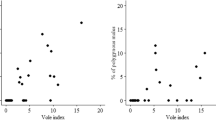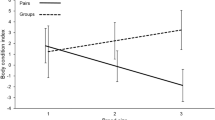Summary
Wild saddle-back tamarins (Saguinus fuscicollis) in southeastern Peru have a variable mating system that can differ both between territories at any one time and within territories over time. Groups are usually monogamous or cooperatively polyandrous, but are occasionally even polygynous. This study addressed the following questions: why does this population contain both monogamous and polyandrous groups simultaneously? What factors determine whether specific groups are monogamous or polyandrous? The data from this study population tentatively support the hypothesis that adults should mate monogramously only if they have nonreproductive helpers (usually older offspring) to help rear infants. Without helpers, the reproductive success of both males and females is hypothesized to be higher, on average, if they mate polyandrously than if they mate monogamously. The proposed benefits of polyandry to males and females differ quantitatively, but in both cases benefits stem from the help that males provide in rearing young. The following results support this hypothesis. (1) Lone pairs were never seen to attempt breeding, and calculations suggest that the costs of lactation and infant-carrying are too great for lone pairs to have a high probability of being able to raise twin offspring (the normal litter size). (2) Polyandrous males and nonreproductive offspring contributed substantially to infant care, particularly infant-carrying (fig. 2). (3) Adult males carried infants approximately twice as often as did lactating females, presumably because of the combined costs of (a) lactation (Fig. 3) and (b) infant-carrying (Fig. 4). The proximate causes of cooperative polyandry inS. fuscicollis appear to be different from those responsible in several bird species, showing that cooperative polyandry is a complex phenomenon.
Similar content being viewed by others
References
Altmann J (1974) Observational study of behavior: sampling methods. Behaviour 49:227–267
Bertram BCR (1978) Living in groups: Predators and prey. In: Krebs JR, Davies NB (eds) Behavioural ecology: An evolutionary approach. Sinauer Associates, Sunderland, Massachusetts, p 64–96
Brown JL (1978) Avian communal breeding systems. Ann Rev Ecol Syst 9:123–155
Craig JL (1984) Are communal pukeko caught in the prisoner's dilemma? Behav Ecol Sociobiol 14:147–150
Davies NB (1983) Polyandry, cloaca-pecking and sperm competition in dunnocks. Nature 302:334–336
Davies NB (1985) Cooperation and conflict among dunnocks,Prunella modularis, in a variable mating system. Anim Behav 33:628–648
Davies NB, Lundberg A (1984) Food distribution and a variable mating system in the dunnock,Prunella modularis. J Anim Ecol 53:895–912
Emlen ST (1982a) The evolution of helping. 1. An ecological constraints model. Am Nat 119:29–39
Emlen ST (1982b) The evolution of helping. 2. The role of behavioral conflict. Am Nat 119:40–53
Emlen ST (1984) Cooperative breeding in birds and mammals. In: Krebs JR, Davies NB (eds) Behavioural ecology: An evolutionary approach 2nd edn, Sinauer Associates, Sunderland, Massachusetts, pp 305–339
Epple G (1978) Reproductive and social behavior of marmosets with special reference to captive breeding. Prim Med 10:50–62
Faaborg J, deVries T, Patterson CB, Griffin CR (1980) Preliminary observations on the occurrence and evolution of polyandry in the Galapagos hawk (Buteo galapagoensis). Auk 97:581–590
Faaborg J, Patterson CB (1981) The characteristics and occurrence of cooperative polyandry. Ibis 123:477–484
Garber PA, Moya L, Malaga C (1984) A preliminary field study of the moustached tamarin monkey (Saguinus mystax) in northeastern Peru: Questions concerned with the evolution of a communal breeding system. Folia Primatol 42:17–32
Goldizen AW (in press) Tamarins and marmosets: Communal care of offspring. In: Smuts BB, Cheney DL, Seyfarth RM, Wrangham RW, Struhsaker TT (eds) Primate Societies. University of Chicago Press, Chicago
Goldizen AW, Terborgh J (1986) Cooperative polyandry and helping behavior in saddle-backed tamarins. In: Lee P, Else JG (eds) Proc Xth Congress of the International Primatological Society: Primate Ecology and Conservation. Cambridge University Press, London, pp 191–198
Hershkovitz P (1977) Living new world monkeys (Platyrrhini), vol 1. University of Chicago Press, Chicago
Hoage RJ (1978) Parental care inLeontopithecus rosalia rosalia: Sex and age differences in carrying behavior and the role of prior experience. In: Kleiman DG (ed) The biology and conservation of the Callitrichidae. Smithsonian Institution Press, Washington DC, pp 293–305
Ingram JC (1978) Parent-infant interactions in the common marmoset (Callithrix jacchus). In: Kleiman DG (ed) The biology and conservation of the Callitrichidae. Smithsonian Institution Press, Washington DC, pp 281–291
Joste N, Ligon JD, Stacey PB (1985) Shared paternity in the acorn woodpecker (Melanerpes formicivorus). Behav Ecol Sociobiol 17:39–41
Kirkwood JK, Underwood SJ (1984) Energy requirements of captive cotton-top tamarins (Saguinus oedipus oedipus). Folia Primatol 42:180–187
Mader WJ (1979) Breeding behavior of a polyandrous trio of Harris' hawks in southern Arizona. Auk 96:776–788
Maynard Smith J, Ridpath MG (1972) Wife sharing in the Tasmanian native hen,Tribonyx mortierii: A case of kin selection? Am Nat 106:447–452
Ridpath MG (1972) The Tasmanian native hen,Tribonyx morterii. II. The individual, the group and the population. CSIRO Wildl Res 17:53–90
Schaik CP van, Noordwijk MA van, Warsono B, Sutriono E (1983) Party size and early detection of predators in Sumatran forest primates. Primates 24:211–221
Skutch AF (1935) Helpers at the nest. Auk 52:257–273
Snowdon CT, Soini P (in press) The tamarins: GenusSaguinus. In: Mittermeier RA, Coimbra-Filho AF (eds) Ecology and behavior of neotropical primates, vol 2, Academia Brasileira de Ciencias, Rio de Janeiro
Sokal RR, Rohlf FJ (1981) Biometry. Freeman and Co, San Francisco
Stacey PB (1979) Kinship, promiscuity and communal breeding in the acorn woodpecker. Behav Ecol Sociobiol 6:53–66
Sussman RW, Kinzey WG (1984) The ecological role of the Callitrichidae: A review. Am J Phys Anthrop 64:419–449
Terborgh J (1983) Five new world primates: A study in comparative ecology. Princeton University Press, Princeton NJ
Terborgh J, Goldizen AW (1985) On the mating system of the cooperatively breeding saddle-backed tamarin (Saguinus fuscicollis). Behav Ecol Sociobiol 16:293–299
Author information
Authors and Affiliations
Rights and permissions
About this article
Cite this article
Goldizen, A.W. Facultative polyandry and the role of infant-carrying in wild saddle-back tamarins (Saguinus fuscicollis). Behav Ecol Sociobiol 20, 99–109 (1987). https://doi.org/10.1007/BF00572631
Received:
Accepted:
Issue Date:
DOI: https://doi.org/10.1007/BF00572631




